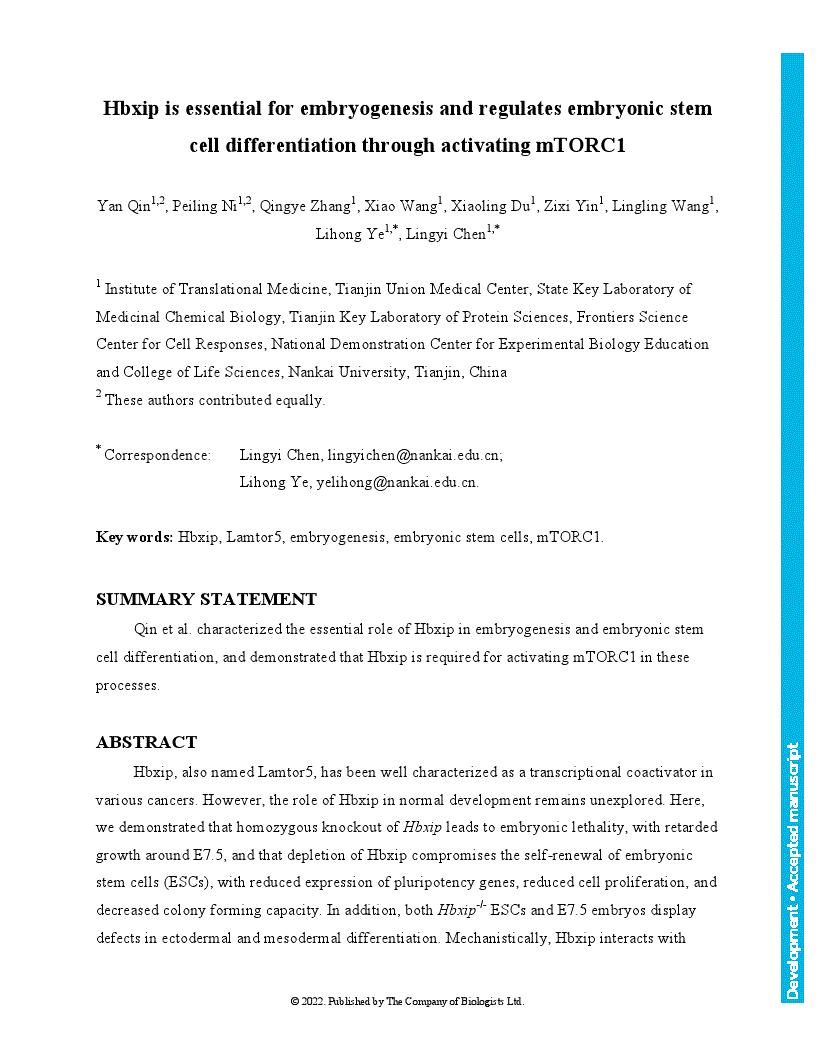Hbxip, also named Lamtor5, has been well characterized as a transcriptional coactivator in various cancers. However, the role of Hbxip in normal development remains unexplored. Here, we demonstrated that homozygous knockout of Hbxip leads to embryonic lethality, with retarded growth around E7.5, and that depletion of Hbxip compromises the self-renewal of embryonic stem cells (ESCs), with reduced expression of pluripotency genes, reduced cell proliferation, and decreased colony forming capacity. In addition, both Hbxip−/- ESCs and E7.5 embryos display defects in ectodermal and mesodermal differentiation. Mechanistically, Hbxip interacts with other components of the Ragulator complex, which is required for mTORC1 activation by amino acids. Importantly, ESCs depleted of Ragulator subunits, Lamtor3 or Lamtor4, display differentiation defects similar to those of Hbxip−/- ESCs. Moreover, Hbxip−/-, p14−/-, and p18−/- mice, lacking subunits of the Ragulator complex, also share similar phenotypes, embryonic lethality and retarded growth around E7-8. Thus, we conclude that Hbxip plays a pivotal role in the development and differentiation of the epiblast, as well as the self-renewal and differentiation of ESCs, through activating mTORC1 signaling.
Hbxip is essential for embryogenesis and regulates embryonic stem cell differentiation through activating mTORC1
These authors contributed equally.
- Award Group:
- Funder(s): National Key Research and Development Program of China
- Award Id(s): 2021YFA1101002
- Funder(s):
- Award Group:
- Funder(s): National Natural Science Foundation of China
- Award Id(s): 31871485
- Funder(s):
- Award Group:
- Funder(s): Natural Science Foundation of Tianjin City
- Award Id(s): 18JCJQJC48400
- Funder(s):
- Award Group:
- Funder(s): China Postdoctoral Science Foundation
- Award Id(s): 2019M660980
- Funder(s):
Currently Viewing Accepted Manuscript - Newer Version Available
Yan Qin, Peiling Ni, Qingye Zhang, Xiao Wang, Xiaoling Du, Zixi Yin, Lingling Wang, Lihong Ye, Lingyi Chen; Hbxip is essential for embryogenesis and regulates embryonic stem cell differentiation through activating mTORC1. Development 2022; dev.200527. doi: https://doi.org/10.1242/dev.200527
Download citation file:
Advertisement
Call for papers: Uncovering Developmental Diversity

Development invites you to submit your latest research to our upcoming special issue: Uncovering Developmental Diversity. This issue will be coordinated by our academic Editor Cassandra Extavour (Harvard University, USA) alongside two Guest Editors: Liam Dolan (Gregor Mendel Institute of Molecular Plant Biology, Austria) and Karen Sears (University of California Los Angeles, USA).
Choose Development in 2024

In this Editorial, Development Editor-in-Chief James Briscoe and Executive Editor Katherine Brown explain how you support your community by publishing in Development and how the journal champions serious science, community connections and progressive publishing.
Journal Meeting: From Stem Cells to Human Development

Register now for the 2024 Development Journal Meeting From Stem Cells to Human Development. Early-bird registration deadline: 3 May. Abstract submission deadline: 21 June.
Pluripotency of a founding field: rebranding developmental biology

This collaborative Perspective, the result of a workshop held in 2023, proposes a set of community actions to increase the visibility of the developmental biology field. The authors make recommendations for new funding streams, frameworks for collaborations and mechanisms by which members of the community can promote themselves and their research.
Read & Publish Open Access publishing: what authors say

We have had great feedback from authors who have benefitted from our Read & Publish agreement with their institution and have been able to publish Open Access with us without paying an APC. Read what they had to say.



